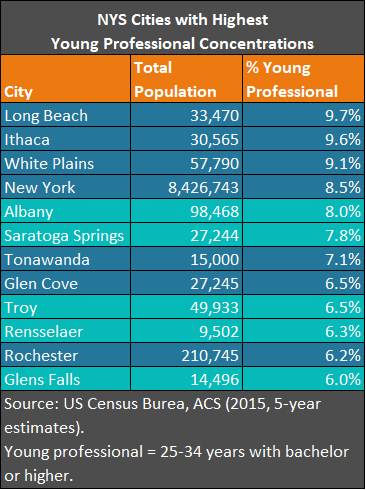Capital Region Cities Emerge as Young Professional Magnets
Amazon’s nationwide search for a site for a $5 billion second headquarters (HQ2) – where it plans to employ up to 50,000 full-time employees – is emphasizing the importance of metros not only creating creating talent but retaining it as well. And that is something Capital Region cities are doing better than most of their counterparts statewide as well as many of the top-ranked contenders for HQ2.
Capital Region cities – particularly Albany – have been receiving more and more national recognition as top locations for young professionals, loosely defined as 25 to 34 year olds with a bachelor’s degree or higher. For example, Forbes named Albany the 21st Best City for Young Professionals, Growella named it the 11th Best City for Millennials and ValuePenguin named the Albany-Schenectady-Troy metropolitan statistical area (MSA) the sixth Best Cities for New Graduates.
Young Professional Concentration
The Lincoln Institute of Land Policy also recently named the City of Albany a High-Performing Small City, in part because of its high concentration of young professionals. In fact, out of the 24 legacy cities in the Mid-West and Northeast included in Lincoln’s study, Albany had the highest concentration of young professionals. In 2015, 8 percent, or 7,857, of the city’s population, were young professionals. Among all cities in New York State, that puts Albany fifth for young professional concentration and second in upstate, trailing Ithaca, according to a Center for Economic Growth analysis of U.S. Census Bureau five-year estimates.
However, Albany was not the only Capital Region city succeeding in creating and retaining young professionals. Out of New York’s top 12 cities with the highest concentrations of young professionals, five of them were in the Capital Region. Other cities in the region with such high concentrations included Saratoga Springs (7.8 percent), Troy (6.5 percent), Rensselaer (6.3 percent) and Glens Falls (6 percent).

Albany even has higher young professional concentrations than several of the cities that Moody’s identified as top contenders for Amazon’s second headquarters (HQ2), including Philadelphia (6.9 percent), Rochester (6.2 percent) and Miami (5.5 percent). However, other top picks, such as Denver and Washington, D.C. have higher young professional concentrations at 11.6 percent and 15.7 percent, respectively.
Producing & Retaining Young Professionals
For Albany’s young professional concentration to rival that of Denver and Washington, D.C., the city would need to boost its number of young professionals by several thousand. Fortunately, Capital Region colleges and universities award thousands of bachelor, master and doctor degrees each year – more than 10,800 in the 2015-2016 school year alone, according to a CEG analysis of Integrated Postsecondary Data System data.
When the Capital Region Economic Development Council (CREDC) last month made its presentation to the New York State Strategic Implementation Assessment Team (SIAT), CREDC members emphasized how many of their priority projects were geared toward making the region more appealing to young professions. Several of those priority projects will enhance the region’s burgeoning craft beverage industry and other areas of the creative economy, such as The Palace Theater’s renovation and revitalization and the Albany Barn’s proposed maker space at Hillside View. Those priority projects are featured in the CREDC 2017 Progress Report.
To help the region retain its young professionals, CEG is also doing the following:
- Hosting speed mentoring events with graduates in the life sciences field. CEG’s Bioconnex program this year hosted speed mentoring events at the University of Albany and Hudson Valley Community College (HVCC), with both events averaging 15 students and five to eight mentors.
- Helping underemployed young professionals find better-paying jobs in manufacturing through a short-term, stackable credential training program. The impetus for HVCC’s new Manufacturing Technology Pathways training program was CEG’s Pathways for Advanced Manufacturing study conducted last spring for the Capital Region Workforce Development Boards.
- Encouraging young girls to explore careers in STEM. For the last five years CEG has hosted the Girls in STEM event that educates girls in grades four through eight about local career opportunities in science, technology, engineering and mathematics fields.
- Helping entrepreneurs from Capital Region colleges and universities successfully launch and grow startups through its Business Growth Solutions program and VentureB.
- Leveraging its Talent Connect program to recruit young professionals from outside the region – at places such as the Massachusetts Institute of Technology and Fort Drum – for employers within the eight counties.
Don’t miss these insights into the trends that are shaping the Capital Region’s economy. Sign up for CEG’s e-news and follow us on:














